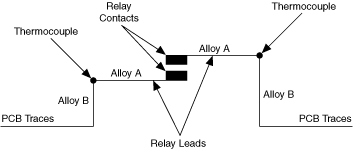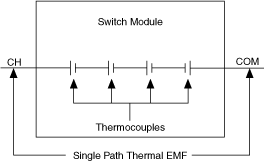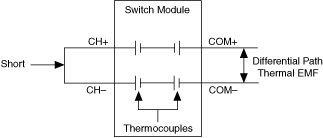Thermal EMF and Offset Voltage
When two, dissimilar metals are joined a voltage is created. This voltage is known as the thermal electromotive force (EMF) or the Seebeck voltage. The Seebeck voltage is dependent on the temperature of the junction and the composition of the metals joined. The specific metal-to-metal junctions result in specific temperature coefficients (µV/°C), also known as Seebeck coefficients. The following table lists the most common metals and their respective Seebeck coefficients.
| Junction | µV/°C |
|---|---|
| Copper-Copper | <0.3 |
| Copper-Gold | 0.5 |
| Copper-Silver | 0.5 |
| Copper-Brass | 3 |
| Copper-Nickel | 10 |
| Copper-Lead-Tin Solder | 1-3 |
| Copper-Aluminum | 5 |
| Copper-Kovar | 40 |
| Copper-Copper Oxide | >500 |
Thermal EMF in switches
The leads of electromechanical relays are usually composed of metal alloys, most often nickel-iron alloy, while the PCB of a switch module is usually composed of copper or copper alloy. The junction between these two, dissimilar metals creates a thermocouple, as illustrated in the following figure.

 |
Note A thermocouple developed in a relay is dependent on the temperature of the junction. The temperature of a junction varies according to the ambient temperature, the number of relays activated, the air flow inside the switch module, and the types of switch modules located in the adjacent slots. |
A signal path can transverse a single relay or multiple relays. The sum of all the thermocouples in a signal path is expressed as the thermal EMF. Thermal EMF can be specified as single path (single wire) or differential path thermal EMF. The following figure illustrates thermal EMF measured in a single path.

The following figure illustrates thermal EMF measured in a differential path.

Accuracy
When measuring voltage with a switch and a DMM, be sure to account for thermal EMF in the overall system accuracy calculation.
For example, if the DMM has an accuracy of 4 µV and the switch has a differential path thermal EMF of 3 µV, the overall system accuracy can be calculated as follows:
√(4² + 3³) = 5 µV
Thus, when measuring a 50 mV signal, the overall system accuracy is 0.01%.
 |
Note For information about thermal EMF and thermocouple measurement, refer to Thermocouple Measurement. |